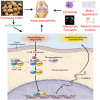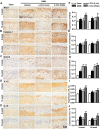α-Chaconine Facilitates Chondrocyte Pyroptosis and Nerve Ingrowth to Aggravate Osteoarthritis Progression by Activating NF-κB Signaling
- PMID: 36263144
- PMCID: PMC9574566
- DOI: 10.2147/JIR.S382675
α-Chaconine Facilitates Chondrocyte Pyroptosis and Nerve Ingrowth to Aggravate Osteoarthritis Progression by Activating NF-κB Signaling
Abstract
Background: With the rapid growth of the elderly population, the incidence of osteoarthritis (OA) increases annually, which has attracted extensive attention in public health. The roles of dietary intake in controlling joint disorders are perhaps one of the most frequently posed questions by OA patients, while the information about the interaction between dietary intake and OA based on scientific research is limited. α-Chaconine is the richest glycoalkaloid in eggplants such as potatoes. Previous evidence suggests that α-Chaconine is a toxic compound to nervous and digestive systems with potentially severe and fatal consequences for humans and farm animals, but its effect on OA development remains obscure.
Objective: To determine whether α-Chaconine deteriorates OA progression through sensory innervation and chondrocyte pyroptosis via regulating nuclear factor-κB (NF-κB) signaling, providing evidence for a possible linkage between α-Chaconine and OA progression.
Methods: We established a mouse OA model by destabilization of medial meniscus (DMM) surgery and then intra-articular injection of 20 or 100 μM α-Chaconine into the OA mice for 8 and 12 weeks. The severity of OA progression was evaluated by histological staining and radiographic analyses. The expressions of matrix metabolic indicators, Col2, Mmp3, and Mmp13, as well as pyroptosis-related proteins, Nlrp3, Caspase-1, Gsdmd, IL-1β, IL-18, were determined by immunohistochemistry. And the changes in sensory nerve ingrowth and activity of NF-κB signaling were determined by immunofluorescence.
Results: We found that α-Chaconine could exacerbate mouse OA progression, resulting in subchondral sclerosis, osteophyte formation, and higher OARSI scores. Specifically, α-Chaconine could augment cartilage matrix degradation and induce chondrocyte pyroptosis and nerve ingrowth. Mechanistical analysis revealed that α-Chaconine stimulated NF-κB signaling by promoting I-κB α phosphorylation and p65 nuclear translocation.
Conclusion: Collectively, our findings raise the possibility that α-Chaconine intake can boost chondrocyte pyroptosis and nerve ingrowth to potentiate OA progression by activating NF-κB signaling.
Keywords: NF-κB signaling; nerve ingrowth; osteoarthritis; pyroptosis; α-Chaconine.
© 2022 Zhang et al.
Conflict of interest statement
The authors report no conflicts of interest in this work.
Figures








Similar articles
-
Morroniside attenuates apoptosis and pyroptosis of chondrocytes and ameliorates osteoarthritic development by inhibiting NF-κB signaling.J Ethnopharmacol. 2021 Feb 10;266:113447. doi: 10.1016/j.jep.2020.113447. Epub 2020 Oct 3. J Ethnopharmacol. 2021. PMID: 33022338
-
α-Solanine attenuates chondrocyte pyroptosis to improve osteoarthritis via suppressing NF-κB pathway.J Cell Mol Med. 2024 Feb;28(4):e18132. doi: 10.1111/jcmm.18132. J Cell Mol Med. 2024. PMID: 38345195 Free PMC article.
-
The IRF1/GBP5 axis promotes osteoarthritis progression by activating chondrocyte pyroptosis.J Orthop Translat. 2023 Dec 29;44:47-59. doi: 10.1016/j.jot.2023.11.005. eCollection 2024 Jan. J Orthop Translat. 2023. PMID: 38229660 Free PMC article.
-
Loganin ameliorates cartilage degeneration and osteoarthritis development in an osteoarthritis mouse model through inhibition of NF-κB activity and pyroptosis in chondrocytes.J Ethnopharmacol. 2020 Jan 30;247:112261. doi: 10.1016/j.jep.2019.112261. Epub 2019 Sep 29. J Ethnopharmacol. 2020. PMID: 31577939
-
Pyroptosis in Osteoarthritis: Molecular Mechanisms and Therapeutic Implications.J Inflamm Res. 2024 Feb 8;17:791-803. doi: 10.2147/JIR.S445573. eCollection 2024. J Inflamm Res. 2024. PMID: 38348279 Free PMC article. Review.
Cited by
-
Nuclear receptor 4A1 inhibits chondrocyte inflammation and cartilage degeneration in osteoarthritis by inhibiting NF-κB signal pathway.Inflammopharmacology. 2025 Apr;33(4):1965-1971. doi: 10.1007/s10787-025-01646-9. Epub 2025 Feb 18. Inflammopharmacology. 2025. PMID: 39964671
-
Systemic Lupus Erythematosus Stimulates Chondrocyte Pyroptosis to Aggravate Arthritis via Suppression of NRF-2/KEAP-1 and NF-κB Pathway.J Inflamm Res. 2025 Mar 20;18:4233-4250. doi: 10.2147/JIR.S502800. eCollection 2025. J Inflamm Res. 2025. PMID: 40129871 Free PMC article.
-
Therapeutic targets and potential delivery systems of melatonin in osteoarthritis.Front Immunol. 2024 Jan 24;15:1331934. doi: 10.3389/fimmu.2024.1331934. eCollection 2024. Front Immunol. 2024. PMID: 38327517 Free PMC article. Review.
-
Systemic Lupus Erythematosus Exacerbates Hip Arthritis by Promoting Chondrocyte Pyroptosis in the Femoral Head via Activating the NF-κB Pathway.J Cell Mol Med. 2025 Apr;29(7):e70531. doi: 10.1111/jcmm.70531. J Cell Mol Med. 2025. PMID: 40179133 Free PMC article.
References
LinkOut - more resources
Full Text Sources
Miscellaneous

